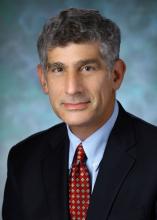RF Biomarker
The case-control study by researchers in Italy and Greece included 80 patients with Sjögren-related MALT lymphoma matched to controls with Sjögren disease who did not have lymphoma.
“We showed that rheumatoid factor positivity at the time of Sjögren’s disease diagnosis serves as the most reliable and temporally distant independent predictor of MALT lymphoma development,” lead author Andreas Goules, MD, a pathophysiologist at the National and Kapodistrian University of Athens, Athens, Greece, told this news organization.
He added that the study found that specific biomarkers in addition to RF positivity were signs of a high risk for MALT lymphoma and a more advanced stage of Sjögren disease–related lymphomagenesis. They included high systemic disease activity, measured as a European Alliance of Associations for Rheumatology Sjögren’s Syndrome Disease Activity Index ≥ 5, and specific B-cell manifestations, such as cryoglobulinemia, salivary gland enlargement, hypocomplementemia, and palpable purpura.
“Ideally, all patients should be evaluated at the time of diagnosis for the presence of RF and undergo a minor salivary gland biopsy to exclude an underlying ongoing lymphoproliferative process,” Dr. Goules said.
RF-positive patients with Sjögren disease require a closer follow-up to identify an advanced stage of lymphoma development, he added.
“It is well known that Sjögren’s disease is characterized by an increased mortality rate, compared to the general population, mainly due to the related lymphomas,” Dr. Goules added. “Thus, the early diagnosis of MALT lymphoma, which is associated with a better prognosis, is expected to improve the overall clinical outcome of Sjögren’s disease patients.”
Rheumatologists and hematologists should employ a similar strategy for Sjögren disease–related large B-cell lymphomas, he said.
“The pathogenetic mechanisms of these two lymphoma types are vastly different, so it wouldn’t be surprising if an entirely different risk factor emerges,” Dr. Goules said. “However, given the rarity of diffuse large B-cell lymphomas, much larger multinational cohorts will be necessary to obtain clinically and pathogenetically meaningful results.”
Alan Baer, MD, a rheumatologist and founder of the Sjögren’s Disease Clinic at Johns Hopkins University in Baltimore, noted Dr. Goules and colleagues are not the first to identify RF, along with a host of other clinical and laboratory findings, as a risk factor for lymphoma in patients with Sjögren disease. “The current study validates rheumatoid factor as an independent risk factor present at a time that is temporally distant from the time of lymphoma diagnosis,” he said.
However, he cautioned that RF alone isn’t highly predictive of Sjögren-related lymphoma. Up to 60% of patients with Sjögren disease are positive for RF at the time of the diagnosis, Dr. Baer said.
“Thus, the finding of rheumatoid factor alone does not necessarily mandate closer surveillance of this group of patients, with the potential for more frequent clinical exams, imaging, and laboratory testing,” he said. “Such an approach has the risk of subjecting patients to unnecessary testing, including invasive procedures.”
More detailed findings, such as if a certain RF level was more predictive of lymphoma or whether other features in combination with RF heightened the risk, would be helpful, he said.



